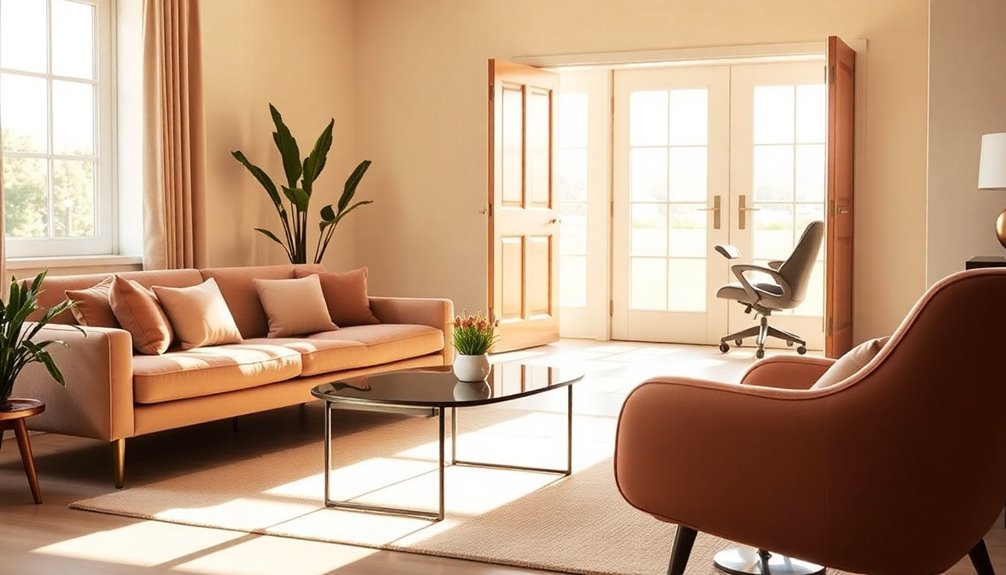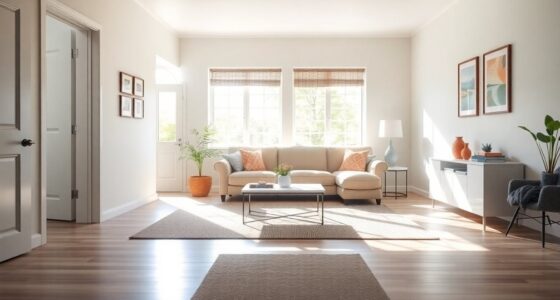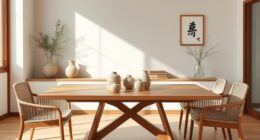Accessible furniture and fixtures are essential for creating inclusive spaces that cater to everyone's needs. Major brands like Pottery Barn and IKEA have embraced this trend, introducing innovative designs that comply with ADA guidelines. However, you might still face challenges like limited choices and high costs. Thankfully, community feedback is driving brands to enhance their offerings. If you want to explore more about stylish and functional options, you'll uncover exciting solutions waiting for you.
Key Takeaways
- Accessible furniture promotes inclusivity, with brands like Pottery Barn and IKEA offering stylish options that comply with ADA guidelines.
- Innovative solutions, such as 3D printable add-ons from ThisAbles, enhance existing furniture for better accessibility.
- Community feedback plays a vital role in shaping designs that meet diverse accessibility needs and preferences.
- Online platforms provide extensive catalogs, making it easier to find stylish and functional accessible furniture options.
- Look for furniture that offers adjustable heights and adequate knee space to ensure comfort and usability for all.
The Importance of Accessible Furniture in Modern Design
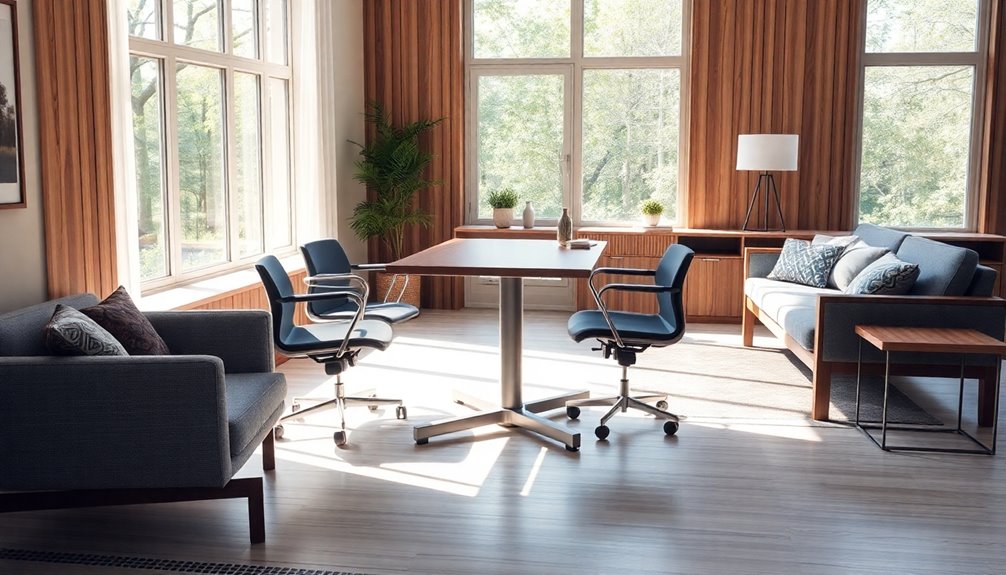
As the demand for inclusivity grows, accessible furniture is becoming a vital aspect of modern design. You'll notice major retailers like Pottery Barn and IKEA adapting their lines with over 150 reimagined products that enhance both accessibility and ergonomics.
The Americans with Disabilities Act (ADA) sets important guidelines, emphasizing adjustable heights and adequate knee space to cater to wheelchair users. Community feedback plays a key role, driving innovative designs that address the unique challenges faced by individuals with disabilities.
In educational settings, adaptive furnishings promote inclusivity by incorporating multi-sensory tools and wheelchair-accessible tables, fostering engagement and participation among all students.
Embracing accessible furniture isn't just about compliance; it's about creating spaces where everyone feels welcome and valued.
Current Challenges in Accessible Furniture Options

Finding accessible furniture options can be frustrating, especially when traversing physical stores that often lack a variety of choices. You might find yourself relying on online shopping, but without the chance to test products, it's tough to verify they meet your needs. Accessibility features can be complex, and limited availability often results in high costs due to monopolistic pricing. Plus, many accessible items resemble medical aids, lacking the aesthetic appeal you desire.
| Feature | Challenge | Example |
|---|---|---|
| Power Lift | High cost due to limited options | $800 for a standard model |
| Aesthetics | Products often unattractive | Medical-looking designs |
| Testing | Inability to try before you buy | Online shopping only |
| Variety | Limited choices in physical stores | Few styles available |
Innovative Solutions From Mainstream Brands
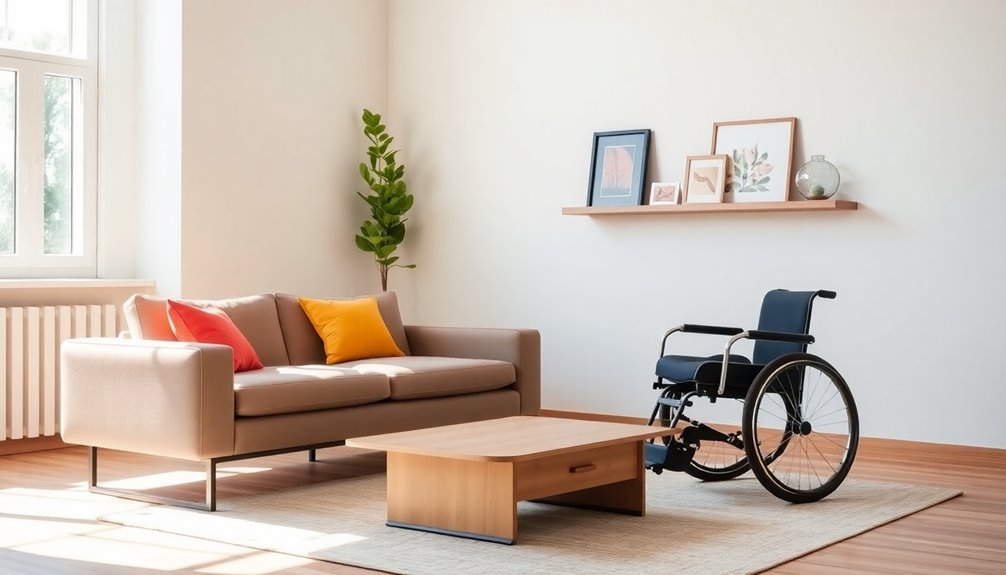
Mainstream brands are stepping up to create innovative solutions that prioritize accessibility in furniture design.
In 2023, Pottery Barn launched over 150 reimagined best-selling products, specifically designed with accessible features like power lift armchairs and adjustable mirrors.
IKEA's OMTÄNKSAM range, developed with ergonomists, enhances comfort, while its ThisAbles initiative offers free 3D printable add-ons for existing furniture to improve accessibility.
Likewise, Target's Design For All Initiative, established in 1997, emphasizes universal design, collaborating with designer Michael Graves on accessible household items.
These brands are responding to consumer feedback, creating innovative solutions that tackle specific accessibility challenges.
This growing trend reflects a shift in consumer expectations, as mainstream brands adapt their product lines to guarantee inclusivity in design.
Community Engagement and Consumer Feedback

To create truly accessible furniture, brands are turning to community engagement and consumer feedback as essential resources. By inviting your input, these companies gain valuable insights into the specific needs and challenges faced by diverse communities.
Engaging with you through surveys and discussions helps brands design furniture with adjustable heights and other features that genuinely address accessibility requirements. Your feedback drives innovations, leading to more ergonomic and user-friendly options that cater to a wider range of abilities.
Many brands are committed to maintaining open lines of communication, ensuring they remain responsive to your needs and preferences. Collaborating with designers who specialize in inclusive design, they create products that aren't just functional but also aesthetically pleasing.
Your voice makes a difference!
Resources for Finding Accessible Furniture

Where can you turn for accessible furniture that meets your needs? Start by exploring online platforms, which offer extensive catalogs, allowing you to compare options effortlessly.
Brands like Pottery Barn and IKEA are adapting their designs to enhance accessibility while maintaining style. Look for furniture that complies with the Disabilities Act (ADA), featuring adjustable heights and sufficient knee space for wheelchair users.
Additionally, many manufacturers provide valuable resources such as whitepapers, guides, and project galleries that showcase innovative designs and best practices in accessible furniture. Engaging with these resources helps you stay informed about the latest trends and solutions tailored to diverse needs, ensuring you find the perfect fit for your space.
Frequently Asked Questions
What Are Examples of Furniture and Fixtures?
When you think about furniture and fixtures, you're considering items that enhance your space and functionality.
Examples include desks, chairs, tables, and shelves that fit your needs. You might also look at fixtures like lighting, cabinets, and storage solutions that organize your environment.
Don't forget about decorative elements such as rugs and artwork, which add character. Each piece plays a role in creating a comfortable and efficient atmosphere for you to enjoy.
What Is Considered Furniture and Fixtures in Accounting?
In accounting, furniture and fixtures include tangible assets like desks, chairs, cabinets, and lighting systems that you use in your business operations.
These items are classified under property, plant, and equipment on your balance sheet and depreciate over time.
When you purchase them, you should consider the total cost, including installation and transportation.
What Category Is Furniture and Fixtures?
Furniture and fixtures fall under the category of movable items that enhance a space's functionality and aesthetics.
You'll find chairs, tables, desks, and shelving units that serve both practical and decorative purposes.
These items are essential for creating inviting environments, whether in homes or businesses.
What Is Furniture for Differently Abled Persons?
Furniture for differently abled persons is designed with specific features to meet diverse physical needs.
You'll find adjustable heights and wider access points that enhance usability and comfort. Ergonomic designs help reduce strain, while wheelchair-accessible tables guarantee ample knee space.
Inclusive seating options make transfers easier, and clearances allow for smooth movement.
As demand grows, many brands are crafting stylish yet functional pieces that seamlessly fit into any home or workspace.
Conclusion
Incorporating accessible furniture into your space isn't just a trend; it's vital for creating an inclusive environment. By understanding the challenges and exploring innovative solutions, you can make informed choices that benefit everyone. Engaging with your community and seeking feedback guarantees that your selections truly meet diverse needs. With the right resources at your fingertips, you've got the power to transform any area into a welcoming and functional space for all. Embrace accessibility in your design journey!
